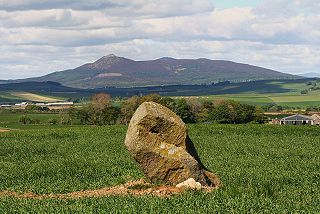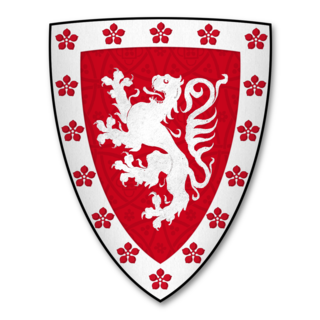Related Research Articles

Francis Hay, 9th Earl of Erroll was a Scottish nobleman. A convert to Catholicism, he openly conspired with the king of Spain to try to unseat the Protestant Queen Elizabeth.

The Battle of Harlaw was a Scottish clan battle fought on 24 July 1411 just north of Inverurie in Aberdeenshire. It was one of a series of battles fought during the Middle Ages between the barons of northeast Scotland against those from the west coast.
In early medieval Scotland, a mormaer was the Gaelic name for a regional or provincial ruler, theoretically second only to the King of Scots, and the senior of a Toísech (chieftain). Mormaers were equivalent to English earls or Continental counts, and the term is often translated into English as 'earl'.
There are currently two earldoms of Mar in the Peerage of Scotland, and the title has been created seven times. The first creation of the earldom is currently held by Margaret of Mar, 31st Countess of Mar, who is also clan chief of Clan Mar. The seventh creation is currently held by James Erskine, 14th Earl of Mar and 16th Earl of Kellie, who is also clan chief of Clan Erskine.

The title Earl of Kellie or Kelly is a title in the Peerage of Scotland, created in 1619 for Sir Thomas Erskine, who was Captain of the Guard and Groom of the Stool for James VI. It is named after Barony of Kellie in Fife, Scotland. Since 1875, it has been held jointly with the Earldom of Mar.

Patrick de Dunbar, 9th Earl of March, was a prominent Scottish magnate during the reigns of Robert the Bruce and David II.
Archibald Douglas, 8th Earl of Angus and 5th Earl of Morton was a Scottish aristocrat.

John Erskine, 1st Earl of Mar was a Scottish aristocrat and politician. He was the custodian of the infant James VI of Scotland and Regent of Scotland.

John Erskine, 2nd Earl of Mar was a Scottish politician, the only son of another John Erskine and Annabella Murray. He is regarded as both the 19th earl and the 2nd earl.
Gartnait of Mar, Earl of Mar – Gartnait mac Domhnall, 8th Mormaer of Mar, was a Scottish noble during the first War of Scottish Independence (1296–1328). His name is sometimes rendered as Gartney or Gratney. A son of Domhnall I, Earl of Mar, and his wife, Elen ferch Llywelyn, Gartnait of Mar died in about 1305.
WilliamIII, 5th Earl of Ross was a fourteenth-century Scottish nobleman. He was the fifth O’Beolan earl of Ross, descending from the founder of the line, Fearchar of Ross.

George Hay, 1st Earl of Kinnoull, was a Scottish nobleman and political official.

Clan Mar is a Scottish clan of the Scottish Lowlands. It is also officially known as the Tribe of Mar. The chiefs of the Clan Mar were the original Earls of Mar, although this title later went via an heiress to the Douglases in the late fourteenth century, and then to the Stewarts before going to the Erskines. The current chief of Clan Mar is Margaret of Mar, Countess.
George Gordon, 2nd Earl of Huntly was a Scottish nobleman and Chancellor of Scotland from 1498 to 1501.

Sir Robert Keith was a Scottish nobleman and a hereditary Great Marischal of Scotland.
Christian or Christina Bruce, also known as Christian or Christina de Brus, was a daughter of Marjorie, Countess of Carrick, and her husband, Robert de Brus, jure uxoris Earl of Carrick, as well as a sister of Robert the Bruce, King of Scots. It is presumed that she and her siblings were born at Turnberry Castle in Carrick.
John Hay, 12th Earl of Erroll was a Scottish nobleman and Lord High Constable of Scotland. Among his titles was Lord of Slains, but he had previously been known as John Hay of Kellour.

William Thomas Hay, 6th Earl of Kinnoull was a Scottish peer. His titles were Earl of Kinnoull, Viscount Dupplin and Lord Hay of Kinfauns in the Peerage of Scotland.

Gilbert Hay, 11th Earl of Erroll PC was a Scottish nobleman.

Charles Hay, 13th Earl of Erroll was a Scottish peer and Lord High Constable of Scotland who strongly opposed the 1707 union of Scotland and England.
References
- ↑ Mackintosh, John (1898). Historic Earls and Earldoms of Scotland. Aberdeen: Jolly. p. 27. Retrieved 9 January 2017.
- ↑ Paul, James Balfour (1908). The Scots Peerage, Vol. 5 (PDF). Edinburgh: Douglas. p. 583. Retrieved 9 January 2017.
- ↑ Mackintosh. Historic Earls. p. 25.
- ↑ Stephen, Leslie (1893). Dictionary of National Biography, Vol. 36. New York: Elder. p. 117. Retrieved 9 January 2017.
- ↑ Paul. Scots Peerage. p. 583.
- ↑ Kellie, Thomas Erskine (1904). Report on the Manuscripts of the Earl of Mar and Kellie. London: H. M. Stationery Office. p. iv. Retrieved 10 January 2017.
- ↑ Selby, Walford D., ed. (1886). The Genealogist (New Series ed.). London: Bell. p. 5. Retrieved 9 January 2017.
- ↑ Anderson, William (1878). The Scottish Nation, Vol. 3. London. p. 109. Retrieved 9 January 2017.
{{cite book}}: CS1 maint: location missing publisher (link) - ↑ Kellie. Report. p. iv.
- ↑ Mackintosh. Historic Earls. p. 27.
- ↑ Paul. Scots Peerage. pp. 583–84.
- ↑ Robertson, Joseph, ed. (1862). Illustrations of the Topography and Antiquities of the Shires of Aberdeen and Banff, Vol. 4. Aberdeen. p. 715. Retrieved 9 January 2017.
{{cite book}}: CS1 maint: location missing publisher (link) - ↑ Anderson. Scottish Nation. p. 109.
- ↑ Mackintosh. Historic Earls. p. 27.
- ↑ Paul. Scots Peerage. p. 584.
- ↑ Selby. Genealogist. p. 5.
- ↑ Anderson. Scottish Nation. p. 109.
- ↑ Paul. Scots Peerage. p. 585.
- ↑ Paul. Scots Peerage. p. 584.
- ↑ Mackintosh. Historic Earls. p. 27.
- ↑ Paul. Scots Peerage. p. 584.
- ↑ "Imaginary Letter of the Hero of Otterburn". Notes and Queries. 4 (6): 362. 29 October 1870.
- ↑ Lindsay, Alexander William C. (1882). The Earldom of Mar in Sunshine and in Shade during Five Hundred Years, Vol. 1. Edinburgh. p. 174. Retrieved 9 January 2017.
{{cite book}}: CS1 maint: location missing publisher (link) - ↑ Law, James Duff (1903). Here and There in Two Hemispheres (First Series ed.). Lancaster, PA: Home. p. 251. Retrieved 9 January 2017.
- ↑ Paul. Scots Peerage. p. 585.